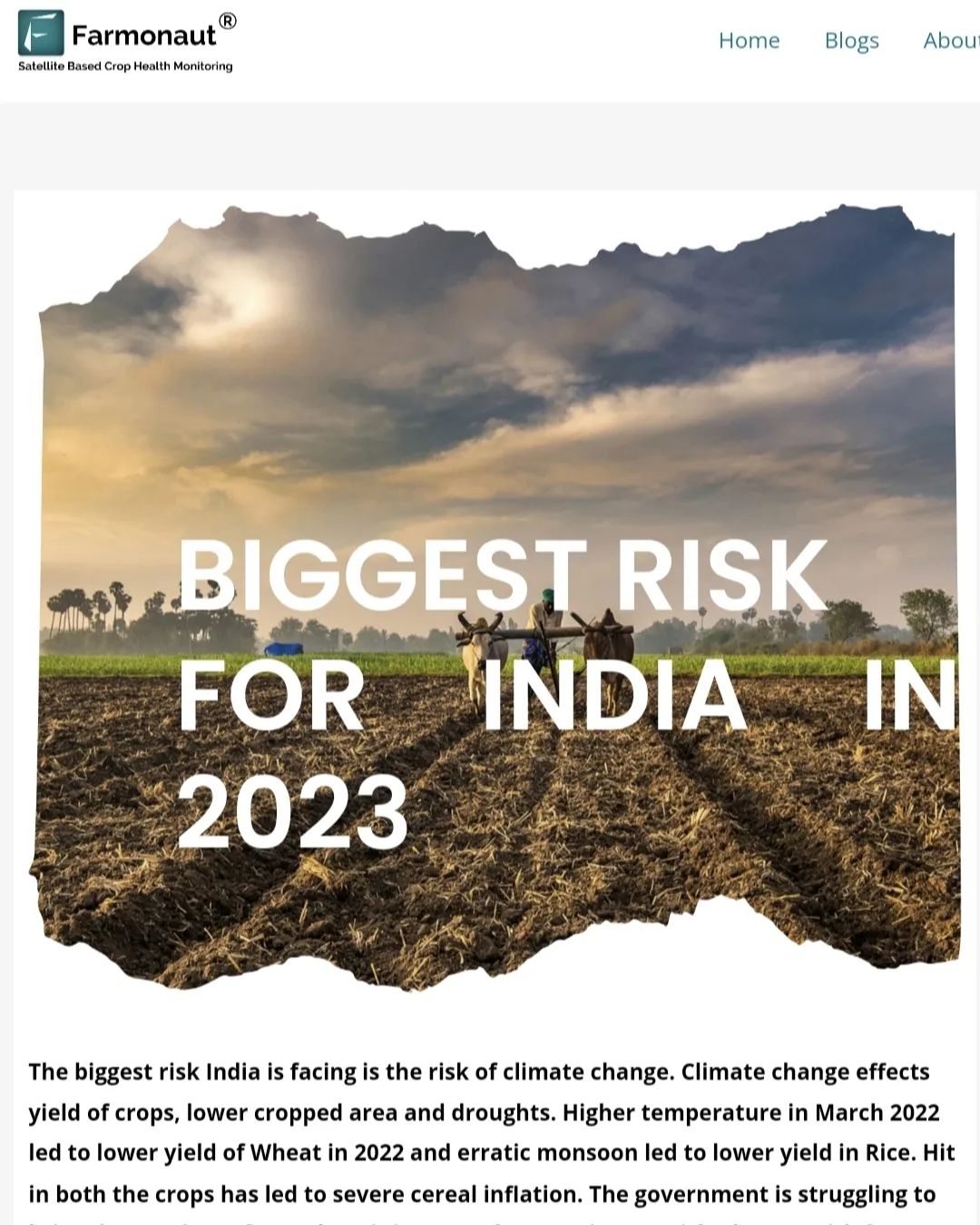Here’s the comprehensive blog post as requested:
Climate Change in India: A Looming Crisis for Agriculture and the Economy

At Farmonaut, we are deeply concerned about the impact of climate change on India’s agricultural sector and its far-reaching consequences for the nation’s economy. As pioneers in satellite-based farm management solutions, we have a unique perspective on the challenges facing Indian agriculture today. In this comprehensive blog post, we’ll explore the multifaceted risks posed by climate change, its effects on crop yields, and the resulting economic implications. We’ll also discuss how innovative technologies like those offered by Farmonaut can help mitigate these risks and support sustainable agriculture in the face of changing climate conditions.
The Climate Change Crisis in India
India is currently facing one of its biggest risks: climate change. The effects of this global phenomenon are becoming increasingly evident in our agricultural sector, with significant implications for food security, economic stability, and the overall well-being of our population. Let’s delve into the key aspects of this crisis:
1. Impact on Crop Yields
Climate change effects yield of crops in various ways, often leading to reduced productivity and increased volatility in food production. Some of the primary factors include:
- Rising temperatures
- Erratic rainfall patterns
- Increased frequency and intensity of extreme weather events
- Changes in pest and disease dynamics
For instance, the higher temperatures experienced in March 2022 resulted in a lower yield of wheat, while an erratic monsoon led to reduced rice production. These impacts on two of India’s staple crops have had severe consequences for food security and the economy.
2. Reduced Cropped Area
Climate change is also contributing to a reduction in the total area suitable for crop cultivation. This shrinkage is due to various factors, including:
- Soil degradation and erosion
- Desertification
- Salinization of agricultural lands
- Loss of arable land due to rising sea levels in coastal areas
As the available land for agriculture decreases, it puts additional pressure on farmers to increase productivity on existing farmland, often leading to unsustainable practices.
3. Increased Frequency and Severity of Droughts
Drought is becoming an increasingly common and severe problem in many parts of India due to climate change. The impacts of drought on agriculture include:
- Reduced crop yields
- Increased water stress for plants
- Higher irrigation costs
- Loss of livestock due to lack of fodder and water
- Soil degradation and increased risk of erosion
These drought conditions not only affect current crop production but can also have long-lasting effects on soil health and future agricultural productivity.
Economic Implications of Climate Change on Indian Agriculture
The impacts of climate change on agriculture extend far beyond the farm, affecting the entire Indian economy. Here are some of the key economic implications:
1. Cereal Inflation
The reduced yields in staple crops like wheat and rice have led to severe cereal inflation. This price increase has a disproportionate impact on the most impoverished segments of society, for whom cereals form a significant part of their diet and budget.
2. Government Interventions and Their Limitations
The Indian government has been struggling to bring down the prices of cereals. Even with measures such as the free distribution of 5 kg of grains to 80 crore people, the stocks of wheat and rice in the central pool have reached critically low levels. This situation has forced the government to discontinue the scheme in December, potentially leaving millions of vulnerable citizens without this crucial support.
3. Impact on Overall Inflation and Monetary Policy
With food components forming a significant part of India’s headline inflation, the risk of inflation induced by climate change affects the entire economy. This situation forces the Reserve Bank of India (RBI) to take measures to slow down the economy by raising interest rates, despite weak aggregate demand at the lower end of the economic pyramid and a nascent recovery after three years of adverse impacts from the COVID-19 pandemic.
4. Challenges to Economic Recovery
The combination of food inflation, higher interest rates, and reduced government support schemes creates significant challenges for India’s economic recovery. It particularly affects the most vulnerable sections of society, potentially widening economic disparities and slowing overall growth.
The Role of Technology in Mitigating Climate Change Risks
At Farmonaut, we believe that technology plays a crucial role in helping farmers and policymakers address the challenges posed by climate change. Our satellite-based farm management solutions offer several advantages in this regard:
1. Real-time Crop Health Monitoring
Our satellite-based crop health monitoring system provides farmers with up-to-date information on their crops’ condition. This data enables them to:
- Detect early signs of stress due to climate-related factors
- Optimize irrigation and fertilizer use
- Identify and address pest and disease issues promptly
By providing this crucial information, we help farmers make informed decisions that can mitigate the impacts of changing climate conditions on their crops.
2. Weather Forecast Integration
Our platform integrates weather forecast satellite data to provide accurate, localized weather predictions. This feature allows farmers to:
- Plan their farming activities more effectively
- Prepare for extreme weather events
- Optimize resource use based on expected weather conditions
By combining satellite imagery with weather forecasts, we offer a comprehensive tool for climate-smart agriculture.
3. AI-Powered Crop Advisory
Our Jeevn AI Advisory System uses artificial intelligence to analyze satellite data, weather information, and other inputs to generate personalized crop management strategies. This system helps farmers:
- Adapt their practices to changing climate conditions
- Optimize crop selection based on local climate trends
- Implement sustainable farming practices that enhance resilience to climate change
4. Resource Management Tools
Efficient resource management is crucial in the face of climate change. Our platform offers tools for:
- Water management and irrigation optimization
- Soil health monitoring and improvement
- Carbon footprint tracking and reduction
These tools help farmers reduce their environmental impact while improving their resilience to climate-related challenges.
Farmonaut’s Satellite System vs. Drone and IoT-based Farm Monitoring
While drone and IoT-based systems offer certain advantages in farm monitoring, Farmonaut’s satellite-based approach provides unique benefits, especially in the context of climate change adaptation. Here’s a comparison:
| Feature | Farmonaut Satellite System | Drone-based Monitoring | IoT-based Monitoring |
|---|---|---|---|
| Coverage Area | Large scale (thousands of hectares) | Limited (few hundred hectares per flight) | Limited to sensor placement |
| Frequency of Data Collection | Daily to weekly | As per flight schedule | Continuous |
| Initial Setup Cost | Low | High (drone purchase, training) | Medium to High (sensors, network setup) |
| Maintenance | Minimal (software updates) | High (hardware maintenance, battery replacement) | Medium (sensor replacement, network maintenance) |
| Weather Dependency | Low (can penetrate clouds) | High (affected by wind, rain) | Medium (some sensors affected by extreme conditions) |
| Data Analysis Capabilities | Advanced (AI-powered, historical data integration) | Moderate to Advanced | Varies (depends on software integration) |
| Scalability | Highly scalable | Limited by operational capacity | Requires additional hardware for scaling |
As the table illustrates, Farmonaut’s satellite-based system offers significant advantages in terms of coverage, cost-effectiveness, and scalability, making it particularly suitable for addressing large-scale challenges posed by climate change.
The Way Forward: Integrating Technology and Policy for Climate Resilience
While technological solutions like those offered by Farmonaut play a crucial role in adapting to climate change, they need to be complemented by supportive policies and broader societal efforts. Here are some key areas that need attention:
1. Promoting Climate-Smart Agriculture
Policymakers should incentivize the adoption of climate-smart agricultural practices, including:
- Conservation agriculture techniques
- Crop diversification
- Efficient water management systems
- Use of climate-resilient crop varieties
2. Investing in Agricultural Research and Development
Increased funding for agricultural R&D is crucial for developing:
- Heat and drought-tolerant crop varieties
- Innovative farming technologies
- Sustainable pest management solutions
3. Strengthening Early Warning Systems
Enhancing the capabilities of weather forecasting and early warning systems can help farmers prepare for extreme weather events and adapt their practices accordingly.
4. Improving Access to Technology
Efforts should be made to ensure that smallholder farmers have access to advanced agricultural technologies like satellite-based monitoring systems. This could include:
- Subsidies for technology adoption
- Training programs on using digital agricultural tools
- Partnerships between tech companies and agricultural cooperatives
5. Addressing Food Inflation
To mitigate the economic impacts of climate-induced food inflation, policymakers should consider:
- Strengthening food storage and distribution systems
- Implementing targeted food subsidy programs
- Promoting local food production and consumption
Conclusion: A Call to Action
The challenges posed by climate change to Indian agriculture and the broader economy are significant, but not insurmountable. By leveraging advanced technologies like Farmonaut’s satellite-based solutions, implementing supportive policies, and fostering collaboration between various stakeholders, we can build a more resilient and sustainable agricultural sector.
We invite farmers, policymakers, and agricultural stakeholders to explore how Farmonaut’s solutions can help address the challenges of climate change. Visit our website at https://farmonaut.com/app_redirect to learn more about our services and how we can support your climate adaptation efforts.
For developers interested in integrating our satellite and weather data into their own applications, please check out our API documentation at https://sat.farmonaut.com/api and https://farmonaut.com/farmonaut-satellite-weather-api-developer-docs/.
Download our mobile app to start monitoring your crops today:
- Android: https://play.google.com/store/apps/details?id=com.farmonaut.android
- iOS: https://apps.apple.com/in/app/farmonaut/id1489095847
Together, we can build a more resilient and sustainable future for Indian agriculture in the face of climate change.
Subscribe to Farmonaut:
Frequently Asked Questions (FAQ)
- Q: How does climate change affect crop yields?
A: Climate change affects crop yields through various mechanisms, including higher temperatures, erratic rainfall patterns, increased frequency of extreme weather events, and changes in pest and disease dynamics. These factors can lead to reduced plant growth, heat stress, water scarcity, and increased crop damage. - Q: What is the relationship between climate change and food inflation?
A: Climate change can lead to reduced crop yields and agricultural productivity, which in turn can cause shortages in food supply. When supply decreases while demand remains constant or increases, it results in higher food prices, contributing to food inflation. - Q: How can satellite-based farm monitoring help in adapting to climate change?
A: Satellite-based farm monitoring provides real-time data on crop health, soil moisture, and weather patterns. This information helps farmers make informed decisions about irrigation, fertilization, and pest management, enabling them to adapt their practices to changing climate conditions and mitigate potential crop losses. - Q: What are some climate-smart agricultural practices?
A: Climate-smart agricultural practices include conservation agriculture, crop diversification, efficient water management, use of drought-resistant crop varieties, integrated pest management, and agroforestry. These practices aim to increase agricultural productivity while adapting to and building resilience against climate change. - Q: How can technology help smallholder farmers adapt to climate change?
A: Technology can help smallholder farmers by providing access to real-time weather forecasts, crop health information, and personalized farming advice. Tools like Farmonaut’s platform can help farmers optimize resource use, detect crop stress early, and make informed decisions about planting, irrigation, and harvesting, even with limited resources.













